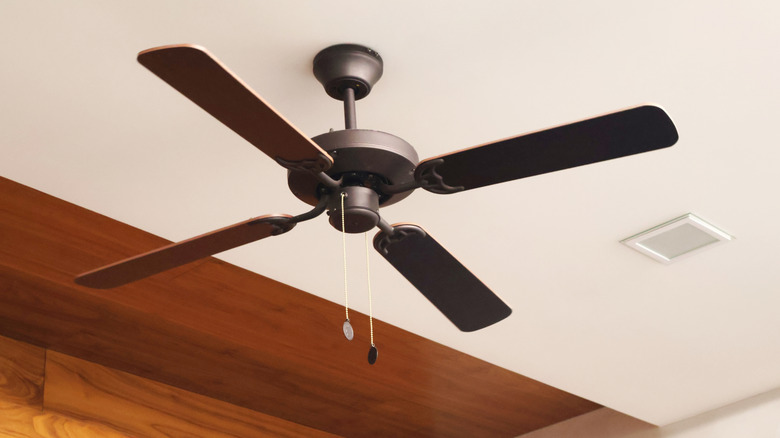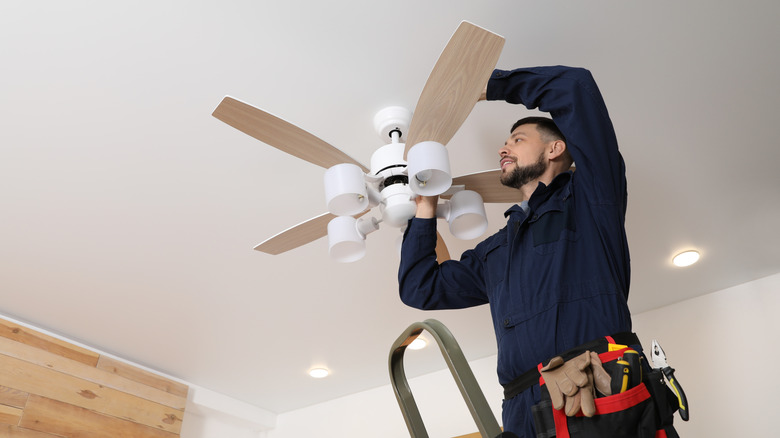How Much Electricity Does A Ceiling Fan Use?
As summer approaches, many of us are looking forward to longer days and outdoor activities while dreading the higher energy bills that come with running air conditioning in our homes. As a solution to this problem, you might consider using energy-saving devices to help you reduce your power bill. That's where ceiling fans come in; depending on the climate where you live, they can help you use your air conditioning less, and on some days, you may be able to get away with not using it at all. While how much electricity a given ceiling fan uses varies based on its size and brand, most of them run on between 50 to 100 watts per hour, meaning it's a cheap operation.
When compared to how much it costs to run a central air conditioner, which can use anywhere from 3,000 to 3,500 watts per hour, you can see how quickly the savings might add up. A budget-friendly air conditioner may not cost as much as central AC, but it'll still cost you more than a ceiling fan. We all know that a fan can't lower the temperature of a room, but it can make the space feel cooler and more comfortable for much cheaper than running the AC all day. And that's why so many people install ceiling fans: they can be an affordable way to stay cool while keeping your electricity use and monthly bill in check.
How much electricity does a ceiling fan use?
Knowing how much energy a ceiling fan uses can help you make smarter decisions about when to turn it on and avoid common mistakes that can increase your energy bill. Keep in mind that the fan's size, speed settings, and how often you run it will all play a role in how much energy it uses overall. While your mileage will also vary based on brand and whether the fan you choose has features like built-in lighting, in general, you can expect a standard 48-inch fan to use about 75 watts per hour. On the extremes, a smaller 24-inch fan may draw as little as 41 watts, and larger 60-inch models can consume up to 120 watts.
To put that in perspective, if you run a 75-watt fan for 6 hours a day, you're only using 13.5 kilowatt-hours (kWh) per month. Based on the average U.S. residential electricity rate of 16.44 cents per kWh, that adds just about $2.22 per month to an energy bill. That's a big saving over central air conditioning, which uses between 3,000 to 3,500 watts per hour and would cost around $100 per month to run 6 hours per day, depending on the unit's power consumption and efficiency. Looking at those numbers, it's easy to see why many people choose to turn on the fan instead of the AC on warm days.
How to reduce ceiling fan energy consumption
Given how energy-efficient ceiling fans are, it may be hard to believe that there are things you can do to stretch your savings even more, starting with buying Energy Star-rated fans. These fans are up to 44% more efficient than standard fans and come with independent certification to back up their energy-saving claims. Investing in a smart fan can save you money by allowing you to automate schedules, adjust settings remotely, and avoid running the fan when you don't need it.
If you already have a ceiling fan and aren't ready to replace it, you can make simple changes like turning it off when you leave a room. Many people live in regions where running the air conditioning is a must. So, if you use a ceiling fan alongside your AC, you can raise the thermostat by about 4 degrees without sacrificing comfort by running the fan counterclockwise, an easy way to lower your overall cooling costs. You should also keep your fan clean and well-maintained. Dirty fan blades can overwork the motor, making your fan less efficient. Regular maintenance will keep it operating optimally throughout the year.


